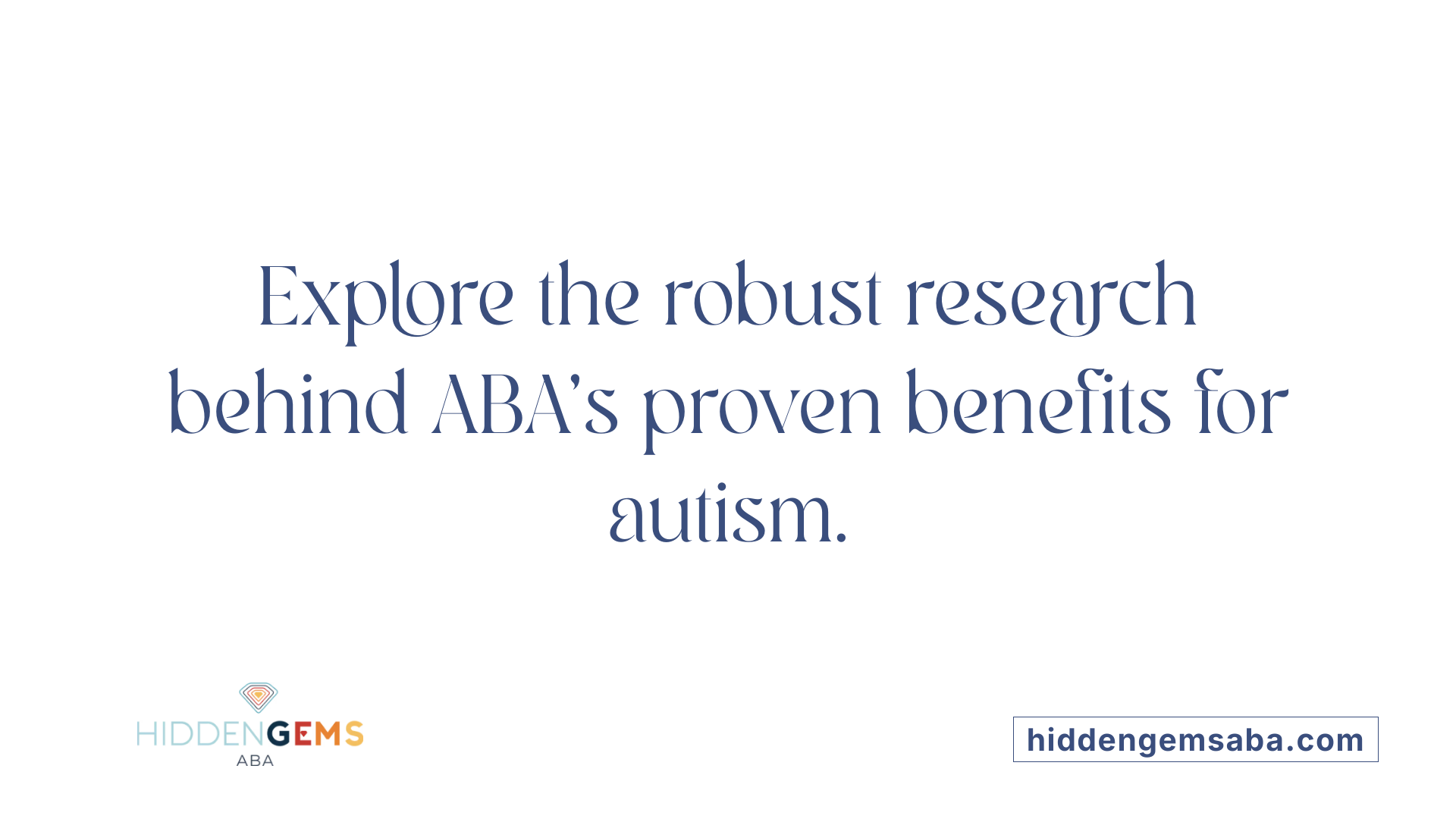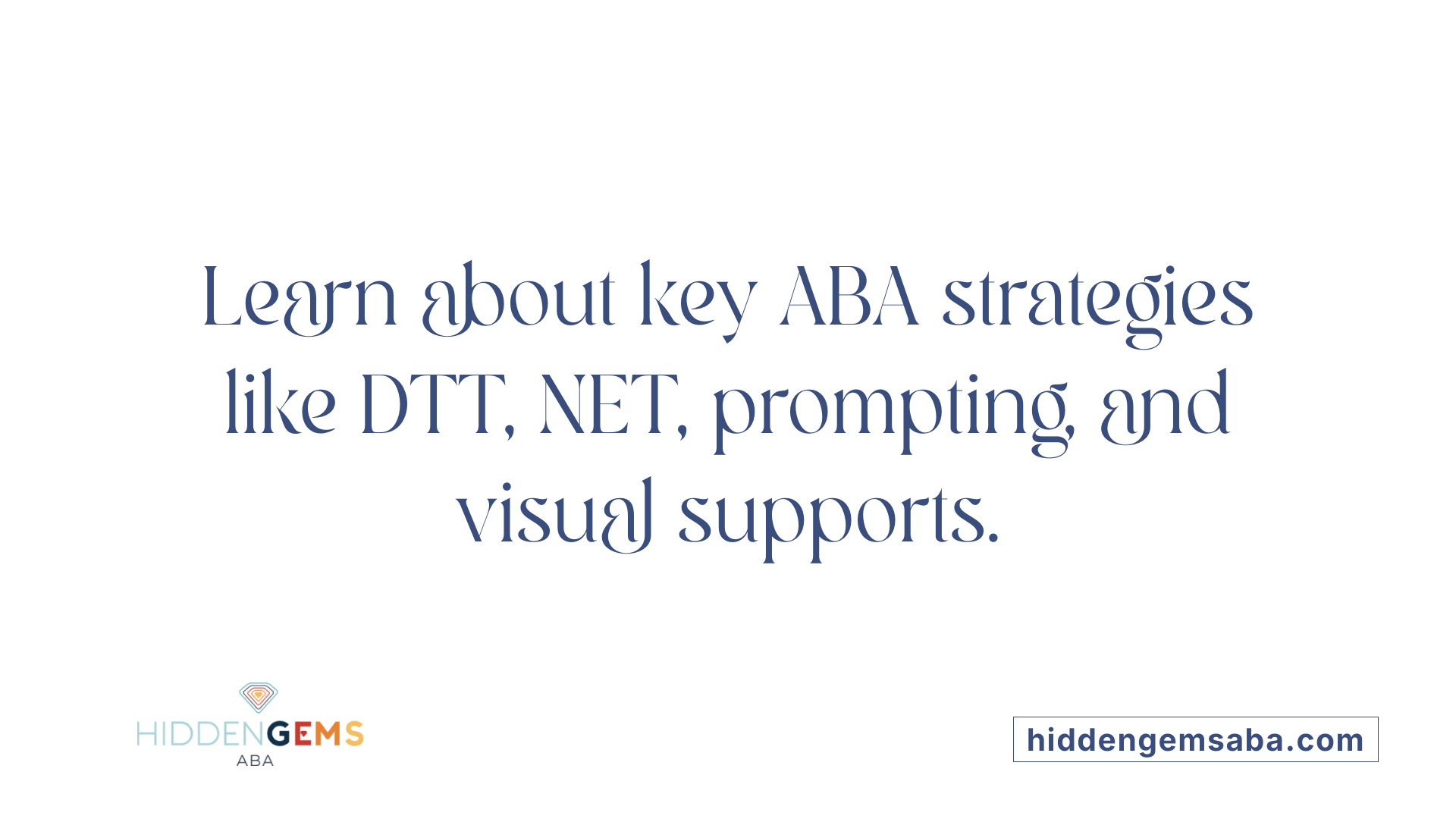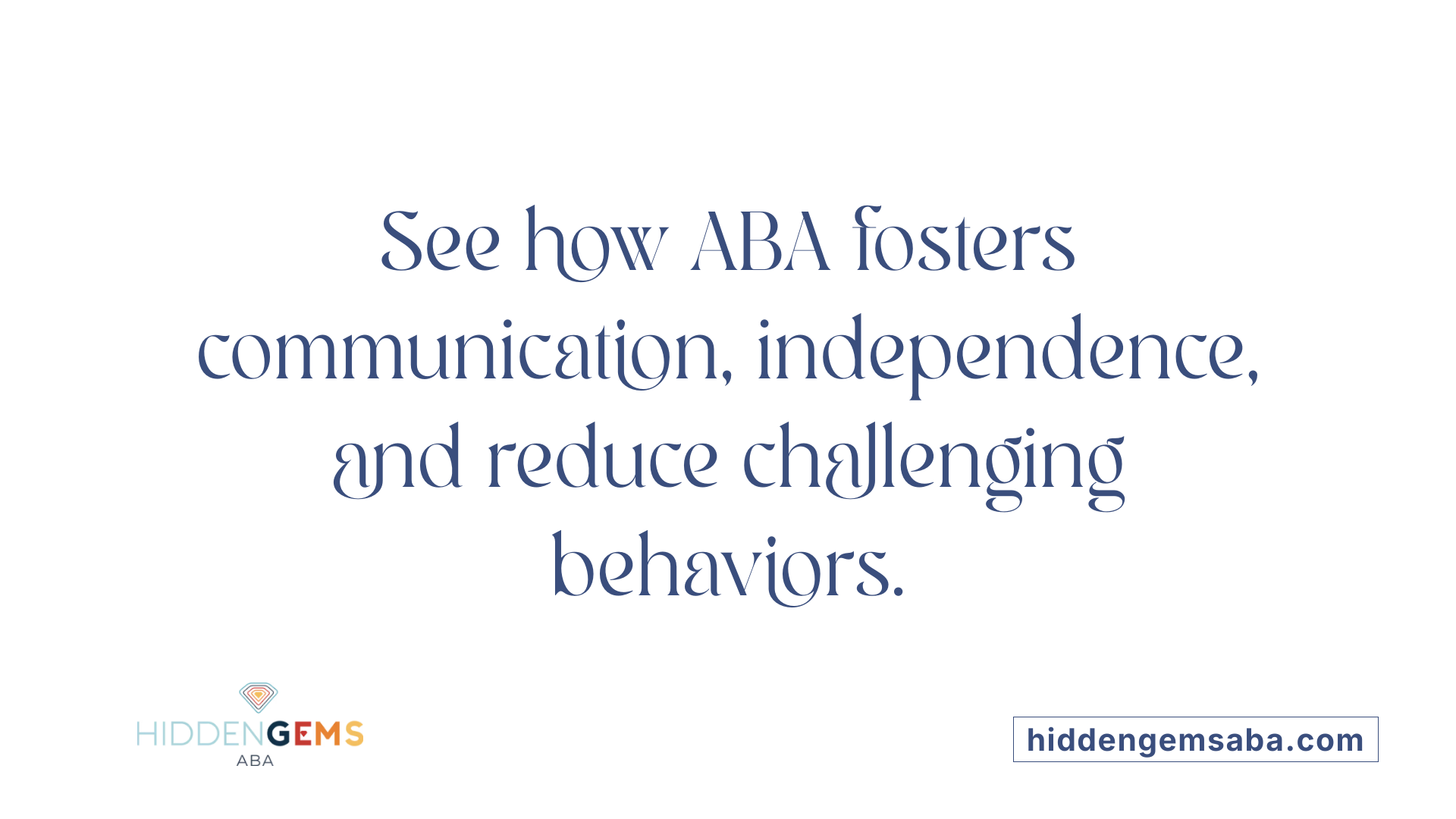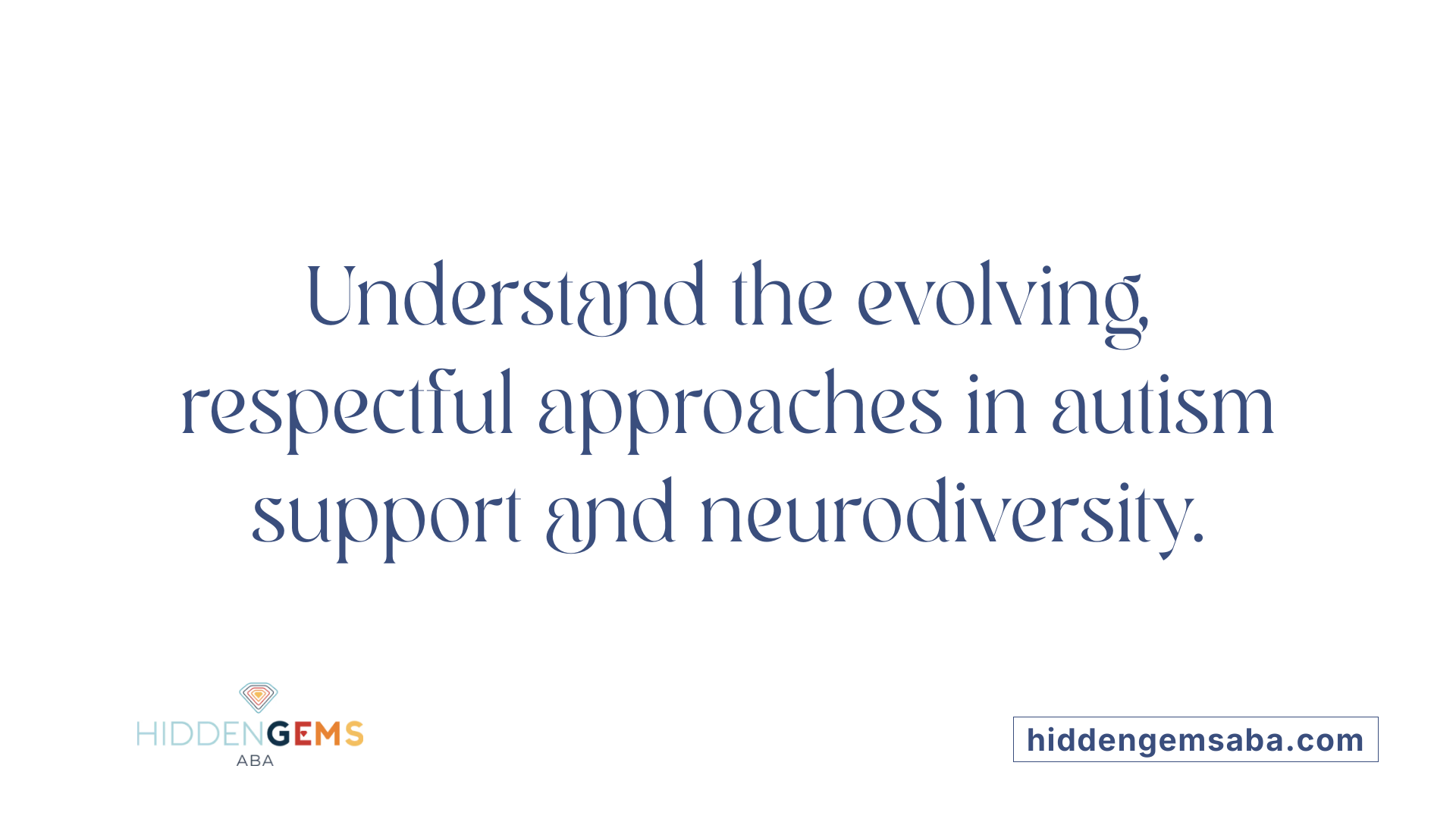Unlocking the Potential of ABA Therapy in Autism Care
Applied Behavior Analysis (ABA) stands as a cornerstone of evidence-based treatment for children and individuals with autism spectrum disorder (ASD). Rooted in scientific principles, ABA therapy employs structured, individualized strategies to foster meaningful behavioral and developmental improvements, supporting children in achieving greater independence, communication skills, and social engagement. This article explores how ABA therapy works, the scientific support behind its effectiveness, the techniques it utilizes, and how families can access and understand this vital treatment approach.
What is ABA Therapy and How Does It Work for Autism Behavior Management?

What is ABA therapy and how does it work for autism behavior management?
Applied Behavior Analysis (ABA) therapy is a scientifically supported, evidence-based approach that helps individuals with autism and related developmental disorders. Its core focus is on understanding how environmental factors influence behavior, enabling tailored strategies to promote positive change.
ABA aims to increase helpful behaviors such as communication, social skills, attention, and academics. At the same time, it seeks to diminish behaviors that interfere with learning or safety. To achieve this, ABA employs techniques like positive reinforcement—rewarding desired behaviors to encourage their recurrence—and prompting, which guides individuals toward the correct behavior.
The therapy is personalized through detailed assessments conducted by board-certified behavior analysts (BCBAs). These professionals develop individualized treatment plans based on an evaluation of the child’s strengths, needs, preferences, and goals. The plans are dynamic, involving ongoing data collection and adjustments to ensure consistent progress.
Different methods are used within ABA, including Discrete Trial Training (DTT), which involves structured, step-by-step teaching, and Natural Environment Teaching (NET), which integrates learning into everyday settings. This flexible approach allows therapy to be offered in various environments—at home, school, or in the community—making skills learned more applicable to real-world situations.
Early, intensive ABA intervention, often more than 20 hours per week during the critical early years, has demonstrated significant developmental improvements. These benefits include better language skills, social interactions, behavior regulation, and increased independence. Overall, ABA aims to help children participate more fully in society by teaching functional skills and reducing challenging behaviors, thus improving their quality of life.
The Scientific Evidence Supporting ABA Effectiveness

Is ABA therapy effective for autism, and what scientific evidence supports its use?
Applied Behavior Analysis (ABA) is extensively studied and widely recognized as an effective treatment for children with autism. Over the past decades, a substantial body of scientific research has demonstrated its positive impact on various developmental and behavioral outcomes.
Many studies, including systematic reviews and meta-analyses of randomized controlled trials, support ABA's efficacy in improving social skills, communication, and adaptive behaviors. These studies have shown consistent evidence that ABA therapy can significantly help children learn to communicate, participate in social interactions, and develop essential life skills.
Effect sizes—the numerical measures of treatment impact—usually indicate moderate to large improvements, especially in areas such as IQ scores, language development, and social responsiveness. These benefits are most pronounced when interventions are intensive, typically involving more than 20 hours of therapy per week over 1 to 3 years.
While ABA has proven effective in many domains, some research findings reveal that it has limited influence on the core symptoms of autism, such as symptom severity or repetitive behaviors. Still, the overall evidence supports the notion that ABA can produce meaningful, measurable behavioral and developmental gains.
The quality of research varies across studies, with many high-quality randomized controlled trials providing robust evidence. However, some studies possess methodological limitations, underscoring the need for continued research. Despite these caveats, major health organizations, including the US and Canadian governments, endorse ABA as an essential, evidence-based treatment for autism.
In conclusion, scientific research overwhelmingly backs ABA as an effective intervention that can improve critical skills and behaviors, particularly when personalized and delivered intensively. Continued research aims to refine these interventions and confirm their long-term benefits.
Research Backing ABA
- Meta-analyses of randomized controlled trials
- Large-scale experimental studies
- Longitudinal research demonstrating sustained benefits
Outcomes Improved by ABA
| Skill Area | Typical Improvements | Supporting Evidence | Importance |
|---|---|---|---|
| Communication | Increased expressive and receptive language | Effect sizes indicating large gains in language development | Fundamental to social integration |
| Social Skills | Better peer interactions and social reciprocity | Improvements in social responsiveness and reciprocity scores | Enhances community participation |
| Adaptive Behavior | Daily living skills like dressing, eating, and self-care | Significant gains documented in skills independence | Promotes autonomy |
| Cognitive Skills | IQ and problem-solving abilities | Moderate to large effect sizes in cognitive assessments | Facilitates learning and school readiness |
| Problem Behaviors | Reduction in challenging behaviors like tantrums | Notable decreases in problem behaviors such as aggression or self-injury | Critical for safety and learning |
Effect Sizes and Long-Term Benefits
Studies report effect sizes ranging from moderate to large, especially with early and intensive intervention. These benefits often persist over time, leading to reduced reliance on special services in adulthood and increased independence.
Role of Intensive Therapy
Research indicates that early and intensive ABA therapy — often more than 20 hours per week — yields the most significant developmental gains. The more hours dedicated to therapy during the critical early years, the better the long-term outcomes in communication, socialization, and overall adaptive functioning.
Core Techniques and Methodologies in ABA

What techniques and methods are used in ABA therapy for autism behavior management?
Applied Behavior Analysis (ABA) employs a diverse set of techniques rooted in behavioral science to help children with autism develop essential skills and reduce interfering behaviors.
One fundamental method is positive reinforcement, which involves rewarding desirable behaviors with praise, tokens, or preferred activities. This encourages the child to repeat those behaviors and helps build new skills across communication, social, and daily living domains.
Another vital concept is the antecedent-behavior-consequence (ABC) model. This approach helps analyze what happens before a behavior (antecedent), the behavior itself, and what follows afterward (consequence). Understanding these elements allows therapists to develop strategies such as extinction (withholding reinforcement for problem behaviors) or redirection, effectively decreasing harmful or unwanted behaviors.
Discrete Trial Training (DTT) is a structured, step-by-step teaching strategy where skills are broken down into small, manageable components. Each trial involves prompting, immediate reinforcement, and repetition to reinforce learning. DTT is particularly effective for teaching new skills in a controlled setting.
Natural Environment Teaching (NET) complements DTT by integrating learning into the child’s natural surroundings, making skills more relevant and easier to generalize. This play-based approach fosters motivation and encourages spontaneous use of skills in real-life situations.
Visual supports, such as picture exchange communication systems (PECS), charts, and visual schedules, are also heavily used. These aids help in understanding and modeling desired behaviors, particularly for children who learn better visually. They serve as effective prompts, support communication, and organize routines.
Prompting and fading involve providing hints or cues to initiate a behavior and gradually removing these prompts as the child gains independence. This process helps to teach and reinforce new skills while encouraging self-reliance.
Behavior chaining breaks complex tasks into smaller, sequential steps, teaching each part individually and then linking them together. This method is particularly useful for teaching self-care routines like dressing, eating, or hygiene.
Together, these techniques form a comprehensive approach to ABA therapy, allowing behavior analysts to tailor interventions that address each child's unique needs. By combining structured instruction, naturalistic learning, visual supports, and behavioral prompts, ABA programs aim to maximize skill acquisition and minimize problematic behaviors across various environments.
Benefits and Outcomes of ABA Therapy

What are the benefits and potential outcomes of ABA therapy for children with autism?
Applied Behavior Analysis (ABA) therapy provides many positive results for children on the autism spectrum. One of its primary advantages is noticeable improvement in essential skills such as language and communication. Children often learn to express their needs more effectively, understand social cues, and participate more actively in interactions.
Beyond communication, ABA helps develop everyday skills like self-care and independence, which are crucial for better integration into school, community, and family life. Many children also see gains in attention span, memory, and academic readiness, setting a foundation for future learning.
A key element of ABA is personalized treatment planning. Each child’s unique needs and preferences are considered when designing goals. Using reinforcement techniques, therapists encourage positive behaviors, which leads to a reduction in problematic or interfering behaviors, such as self-injury or tantrums.
Evidence from numerous studies demonstrates that consistent, high-quality ABA can lead to meaningful developmental changes. Typically, children benefit most from about 12 to 24 months of dedicated therapy, especially when initiated early in life.
The long-term benefits extend beyond immediate skills. Many children develop greater independence and improved social skills, allowing them to participate more fully in community activities and relationships.
Overall, ABA therapy aims to maximize each child’s potential by fostering meaningful skill acquisition and reducing barriers to social participation. This comprehensive approach strives not only to teach new skills but to improve overall quality of life for children with autism and their families.
How does ABA facilitate behavior change and skill development?
ABA employs understanding environmental triggers and consequences to modify behavior effectively. Strategies like positive reinforcement promote desired responses, while techniques such as prompting, fading, and chaining help build complex skills gradually.
The progress made through ABA can be tracked with ongoing data collection, ensuring that the interventions are effective and adapted as needed. This systematic approach ensures measurable and consistent improvements, setting children on a trajectory toward greater autonomy.
Expected long-term effects and developmental gains
Long-term benefits of ABA are supported by evidence showing improvements in cognition, social interactions, and adaptive behaviors. Many children who undergo early intensive intervention experience reduced need for additional services later in life.
By promoting essential life skills and social participation, ABA contributes significantly to the overall development and well-being of children with autism. This can lead to better educational outcomes and increased opportunities for employment and social inclusion in adulthood.
| Aspect | Benefits | Additional Details |
|---|---|---|
| Skills Development | Language, social, self-care, academic | Tailored to individual needs, using reinforcement and natural environmental learning |
| Behavior Reduction | Fewer challenging behaviors | Systematic analysis of antecedents and consequences to alter behaviors |
| Independence & Social Skills | Greater autonomy, better peer relationships | Long-term gains support integration into broader social settings |
| Long-term Benefits | Enhanced quality of life, reduced support needs | Early and sustained intervention can be pivotal |
The comprehensive view of ABA highlights its role as a scientifically supported therapy that promotes meaningful, lasting change in the lives of children with autism.
Different Approaches and Strategies within ABA
What different approaches and strategies are used within ABA therapy for autism spectrum disorder?
ABA therapy employs a diverse set of techniques and approaches that are customized to meet each child's unique needs. These strategies are rooted in behavioral science principles, particularly reinforcement, and include both structured and naturalistic methods.
One of the most well-known approaches is Discrete Trial Training (DTT). DTT involves breaking down skills into small, manageable steps. Each step is practiced through repeated trials, with desirable behaviors reinforced immediately to encourage mastery. This structured approach is effective for teaching new skills systematically.
In contrast, Natural Environment Teaching (NET) emphasizes learning in everyday settings. It integrates therapy into the child's natural routines and interests, promoting generalization of skills across different environments. This approach helps children apply skills in real-world situations, such as at home or in the community.
Pivotal Response Treatment (PRT) is another naturalistic method. PRT focuses on 'pivotal' areas like motivation, self-initiation, and social responsiveness. By targeting these pivotal skills, children often acquire a range of other skills more effectively. PRT is play-based and takes place in the child's natural environment, making learning engaging and relevant.
Reinforcement — both positive and negative — is central to ABA. Positive reinforcement involves giving something desirable, like praise, tokens, or access to preferred activities, to encourage the recurrence of desired behaviors. Negative reinforcement removes an unpleasant condition to promote a particular response. These methods motivate children to learn new behaviors and improve existing ones.
To help children acquire and retain skills, prompting and fading are used extensively. Prompting provides cues or assistance to initiate a behavior, and fading gradually removes these prompts as the child becomes more independent. This process supports skill acquisition while fostering autonomy.
Behavior chaining is a technique where complex behaviors are divided into smaller, sequential steps. Each step is taught individually and then linked together to perform the entire task. This method is useful for teaching functional skills like dressing or toileting.
Visual supports such as modeling, picture exchange communication systems (PECS), and video modeling utilize the visual strengths of many children with autism. These tools help children understand expectations and learn new skills by providing clear, concrete visual cues.
Behavior contracts formalize behavioral goals and outline rewards or consequences, promoting accountability and consistency. Social skills training often accompanies ABA, teaching children how to interact appropriately with peers and adults.
Overall, ABA strategies are evidence-based and highly adaptable. Therapists combine these approaches, integrating structured and naturalistic techniques to enhance communication, social skills, adaptive behaviors, and reduce problematic behaviors across various settings, including home, school, and community environments.
Accessing ABA Services and Navigating the Therapeutic Process
How can I learn more about ABA therapy and autism treatment options?
To become well-informed about ABA therapy and available autism treatment options, start by consulting reputable sources. National organizations such as Autism Speaks and the Autism Society offer comprehensive guides and resources on intervention methods. Medical websites and research institutions also provide detailed information about evidence-based treatments.
Meeting with qualified professionals like Board Certified Behavior Analysts (BCBAs) is a crucial step. These experts can offer tailored advice based on your child's unique needs and explain different ABA techniques, such as Discrete Trial Training (DTT), Pivotal Response Training (PRT), and Early Start Denver Model (ESDM).
It’s also helpful to communicate with your healthcare provider or pediatrician, who can recommend specialized services in your locality. Attending workshops, webinars, or support groups focused on autism therapies can further deepen your understanding of ABA and other intervention strategies.
Reading scientific articles and research papers from trusted institutions can offer insights into the effectiveness and application of ABA therapy. Gathering comprehensive information empowers you to make informed decisions about your child's care.
How do I determine my child's eligibility for ABA?
Eligibility for ABA services generally begins with a formal diagnosis of autism spectrum disorder (ASD) by a licensed healthcare professional. Once diagnosed, a Functional Behavior Assessment (FBA) performed by a BCBA helps identify specific needs and skills gaps. Based on the assessment, an individualized treatment plan is developed.
Most insurance plans, including Medicaid, recognize ABA as a covered service when deemed medically necessary. Eligibility can depend on state laws, insurance policies, and whether the child's conditions meet the criteria.
Educational and developmental programs often collaborate with healthcare providers to facilitate access. Early intervention programs are especially effective for children aged 2 to 6, as early ABA can improve communication, social skills, and reduce problematic behaviors.
How can I navigate insurance and funding options?
Navigating funding sources may seem daunting, but understanding your options can ease the process. Many private insurance plans, in addition to Medicaid, cover ABA therapy when medically necessary. It’s important to verify coverage details, including session limits, provider requirements, and documentation needs.
For those without insurance or facing coverage limitations, various state-funded programs, grants, or non-profit organizations may provide financial assistance or sliding scale fees. Some programs also include a focus on family training and support.
When applying for coverage, ensure that your provider is credentialed and that the therapy is prescribed by a licensed healthcare professional. Keep detailed records of diagnoses, assessments, and treatment plans to facilitate approval and reimbursement.
How is the initial assessment conducted and what does treatment planning involve?
The initial assessment begins with a comprehensive evaluation by a BCBA, who reviews medical history, developmental milestones, and behavioral patterns. Observations and standardized assessments help identify strengths and target areas for growth.
This process often involves parent interviews, direct observation, and behavioral data collection. The information gathered guides the formulation of a personalized treatment plan, emphasizing goals such as communication improvement, social skills, academic readiness, and behavior reduction.
Treatment planning includes setting specific, measurable objectives and selecting suitable ABA methods like DTT, PRT, or NET. The plan also details the frequency and setting of therapy sessions, along with strategies for family involvement.
Ongoing data collection ensures progress tracking, and plans are regularly adjusted to meet evolving needs.
How is therapy delivered and what role do families play?
ABA therapy can be provided in various environments, including at home, in school, or in community settings. The therapy sessions are tailored to the child's age, needs, and environment, often involving one-on-one instruction with trained behavior technicians supervised by a BCBA.
Family involvement is essential for maximizing the benefits of ABA. Parents and caregivers are encouraged to learn and implement strategies, such as reinforcement techniques, behavioral prompts, and redirection, between formal sessions.
Training may include instruction on managing challenging behaviors, supporting social interactions, and generalizing learned skills across settings. Active participation helps children apply new skills consistently and comfortably.
How is progress monitored and adjustments made to therapy?
Progress in ABA therapy is continuously monitored through systematic data collection during sessions. This data tracks specific behaviors, skill acquisition, and response to interventions.
Regular review meetings with the BCBA assess progress toward goals and determine if adjustments are needed. If a child is not progressing as expected, strategies may be modified, or the intensity of therapy increased.
Treatment plans are flexible and tailored to the child's evolving development, ensuring each intervention remains effective and relevant.
| Topics Covered | Details | Additional Notes |
|---|---|---|
| Learning about ABA | Use reputable organizations, consult professionals, attend workshops, review research | Empowers informed decisions |
| Eligibility criteria | Diagnosis, ABA assessment, insurance recognition | Early intervention is critical |
| Insurance and funding options | Private insurance, Medicaid, grants, community programs | Verify provider credentials and documentation |
| Initial assessment process | Review history, behavior observations, plan development | Involves parents and other caregivers |
| Therapy delivery and family role | Settings vary, active caregiver participation encouraged | Reinforces skill generalization |
| Progress monitoring and adjustments | Data-driven reviews, plan modifications, ongoing assessment | Ensures therapy remains effective |
By understanding these components, families can navigate the application process comfortably and support their child's development through effective ABA interventions.
Addressing Controversies and Supporting Neurodiversity

What are the benefits, controversies, and alternatives to ABA therapy for autism?
Applied Behavior Analysis (ABA) is a widely recognized and evidence-based therapy designed to improve various skills such as communication, social interactions, and independence in children with autism. Its data-driven nature and ability to tailor interventions to individual needs have made it the preferred choice for many families and practitioners. ABA often involves breaking down complex skills into manageable steps, rewarding positive behaviors, and gradually fostering independence.
However, ABA has faced significant scrutiny over its historical and current practices. Historically, some early ABA programs, particularly those developed in the 1960s by Dr. Lovaas, employed aversive techniques, punishment, and reward-based systems that could cause emotional distress. Critics argue that those methods, especially when applied without consent or sensitivity, contributed to trauma and negatively impacted the children’s well-being.
Concerns also center around the focus on conformity. Some advocates feel that ABA's emphasis on reducing behaviors deemed undesirable may overshadow the importance of respecting individual neurodiversity and authentic self-expression. This has led to accusations that traditional ABA could promote masking, which involves suppressing natural behaviors to appear more 'typical,' potentially leading to increased anxiety or identity issues.
In response to these criticisms, modern ABA practices have shifted toward more compassionate and naturalistic approaches. These emphasize play-based learning, client empowerment, and strength-based strategies. Many practitioners now focus on improving quality of life, fostering genuine interests, and supporting individual preferences, aligning more closely with the principles of neurodiversity.
Besides ABA, several alternative therapies are available that focus on individualizing support without the ideological emphasis on behavioral conformity. Speech therapy and occupational therapy work on developing communication and daily living skills. Social skills training groups aim to enhance interpersonal understanding. The TEACCH approach uses visual supports and structured teaching environments to boost learning and independence. Cognitive-behavioral therapy (CBT) and other psychological interventions can help manage co-occurring mental health issues.
Why consider alternatives or modifications to traditional ABA?
Choosing the right intervention depends on the child's needs and the family’s values. Many families seek approaches that respect the child’s individuality and promote well-being beyond simply reducing behaviors. Addressing controversies around ABA involves balancing scientifically supported techniques with ethical considerations and cultural sensitivities.
Ultimately, ongoing research and dialogue aim to refine autism support strategies, ensuring they are compassionate, effective, and respect neurodiversity. Families are encouraged to ask detailed questions and consider a range of options, embracing approaches that prioritize personal growth and quality of life.
| Aspect | Traditional ABA | Modern Approaches | Focus |
|---|---|---|---|
| Techniques | Punishment, reward, aversive methods | Play-based, naturalistic, client-centered | Behavior change, quality of life |
| Emphasis | Conformity, masking | Authentic self-expression, empowerment | Self-advocacy, individuality |
| Concerns | Emotional trauma, suppression | Respect, consent, well-being | Ethical practices |
| Alternatives | Speech therapy, OT, TEACCH | Social skills groups, CBT | Support based on preferences |
Questions about the controversies surrounding ABA and its evolving practices highlight the importance of personalized, respectful, and effective autism support options. Families are encouraged to collaborate with professionals to build interventions that foster genuine growth while respecting neurodiversity.
How to Access and Understand the ABA Therapeutic Process
How does one access ABA services and understand the therapeutic process?
Accessing ABA therapy begins with obtaining a formal diagnosis of autism spectrum disorder (ASD) from a qualified healthcare professional, such as a pediatrician or developmental specialist. This diagnosis is essential, especially since many insurance plans, including Medicaid and private insurers, require it for coverage.
Once diagnosed, families should review their health insurance policies to understand the specifics of covered services. This includes checking for pre-authorization requirements, listing of in-network providers, and documentation needs, which vary among plans.
The next step is to find a qualified ABA provider. Look for board-certified behavior analysts (BCBAs) or trained therapists with the necessary credentials, including certification in ABA (such as RBT or ABAT). Contact these professionals to schedule an initial assessment.
The initial assessment is a comprehensive process where the BCBA evaluates the child's current skills, behaviors, and needs through interviews, direct observations, and review of developmental history. This evaluation helps identify strengths, challenges, and specific areas for intervention.
Based on this assessment, the BCBA develops an individualized treatment plan that outlines clear, measurable goals tailored to the child's unique needs. The plan includes strategies for skill development and behavior management, often involving family participation to ensure consistency across settings.
Begin therapy sessions, which might be conducted at home, in clinics, or in community settings. Early intervention, typically starting between ages 2 and 6, can significantly improve communication, social skills, and behavior.
Throughout the therapeutic process, ongoing data collection and progress monitoring are vital. Regular reviews allow the BCBA to adjust strategies, set new goals, and ensure the intervention remains effective.
Families are encouraged to maintain open communication with providers to navigate scheduling, billing, and any necessary adjustments. Also, consulting with insurance representatives can clarify coverage, claims processes, and documentation procedures.
Understanding the ABA process involves recognizing its systematic, individualized approach rooted in behavioral science. It centers on teaching new skills and reducing problematic behaviors through positive reinforcement and data-driven decisions.
Overall, accessing ABA services entails thorough planning, collaboration with qualified professionals, and active family engagement, all aimed at supporting the child's development and quality of life.
Conclusion: The Path Forward in Autism Support with ABA
What are the benefits, controversies, and alternatives to ABA therapy for autism?
Applied Behavior Analysis (ABA) remains the most researched and widely endorsed behavioral intervention for autism, demonstrating consistent benefits such as improving communication, social skills, independence, and reducing problematic behaviors. Because ABA is based on scientific principles, personalized intervention plans developed by trained professionals have shown significant positive outcomes in many children.
However, ABA has historically been controversial. In its early days, some techniques used punishment and aversive methods, which are no longer acceptable and have been largely abandoned. Critics argue that traditional ABA overly emphasizes conformity and suppresses genuine autistic behaviors, leading to concerns about emotional distress, trauma, and even post-traumatic stress disorder (PTSD). There is also worry that such approaches may encourage masking, where children hide their natural traits, which can negatively impact their well-being and self-identity.
In response, modern ABA practices have shifted toward more respectful, play-based, naturalistic, and strengths-focused approaches. These emphasize client empowerment, choice, and accommodating individual neurodiversity, aiming to support authentic self-expression while promoting skill development.
Beyond ABA, alternative therapies and support options are available. These include speech therapy, occupational therapy, social skills training, TEACCH (Treatment and Education of Autistic and related Communication Handicapped Children), and cognitive-behavioral therapy (CBT). These approaches tend to focus more on supporting the individual’s specific needs and preferences without emphasizing conformity to typical development. Such alternatives prioritize the child’s well-being, emotional health, and quality of life.
Overall, the future of autism support increasingly advocates for a collaborative, individualized, and respectful approach. The shift aims to balance skill development with honoring neurodiversity and personal identity.
Why is early intervention important?
Research consistently shows that early intervention, especially with ABA starting between ages 2 and 6, can lead to considerable developmental gains. Early therapy can improve communication skills, social engagement, and daily living skills, often setting children on a more successful lifelong trajectory.
Acting during the critical early years maximizes neuroplasticity, allowing children to acquire fundamental skills and adapt more readily to their environments. Early ABA treatment can also reduce future dependence on intensive services, fostering greater independence and participation in community life.
How does a collaborative, individualized treatment approach benefit children?
Every child with autism has unique strengths, challenges, preferences, and goals. Tailoring interventions to their specific needs ensures the most effective support. This customization involves thorough assessments by professionals such as Board Certified Behavior Analysts (BCBAs) and ongoing data collection to track progress.
Involving families in developing and implementing treatment plans enhances consistency and generalization of skills across settings. Cooperation among therapists, educators, and caregivers creates a supportive network that encourages meaningful progress.
Why is respect for neurodiversity essential?
Acknowledging neurodiversity means recognizing autism as a natural variation of human brain wiring rather than only a disorder to be cured. Respecting neurodiversity promotes acceptance, self-determination, and the celebration of individual differences.
Supporting autonomy, fostering self-advocacy, and providing accommodations empower autistic individuals to thrive on their own terms. Emphasizing neurodiversity shifts the focus from normalization to inclusion, dignity, and quality of life.
| Aspect | Traditional ABA | Modern, Respectful Approaches | Focus | Implementation | Goals |
|---|---|---|---|---|---|
| Techniques | Discrete trials, reinforcement | Naturalistic, play-based, strengths-focused | Skill acquisition, behavior reduction | Individualized, family-centered | Independence, authenticity |
| Controversies | Use of aversive methods, masking | Respect for self-expression, neurodiversity | Self-identity, emotional health | Collaborative, choice-driven | Well-being, community integration |
| Alternatives | Speech therapy, occupational therapy, TEACCH | Same as above plus social skills, CBT | Supporting preferences & needs | Tailored, inclusive | Self-advocacy, dignity |
Understanding both the benefits and controversies surrounding ABA, and recognizing the value of alternative approaches, guides us toward a more inclusive future. The goal is to support autistic individuals in living meaningful, fulfilling lives aligned with their identities and aspirations.
Shaping a Future of Inclusive and Tailored Autism Support
The landscape of autism intervention continues to evolve, with ABA remaining a vital, research-supported option that can significantly improve functional outcomes when applied thoughtfully and ethically. Emphasizing early, intensive, and individualized care, ABA encourages children to develop essential skills while respecting their unique identities and neurodiversity. Collaborations among families, professionals, and advocates are critical to expanding understanding, reducing misconceptions, and fostering more inclusive practices. With ongoing advances and a focus on empowerment, the goal is to create a future where every individual with autism receives compassionate, personalized support that celebrates their strengths and enhances their quality of life.
References
- Applied Behavior Analysis (ABA)
- Behavioral Management Therapy for Autism | NICHD
- Applied Behavior Analysis (ABA)
- Treatment and Intervention for Autism Spectrum Disorder
- Applied Behavior Analysis in Children and Youth with ...
- ABA Techniques: Strategies for Behavior Analysts - GSEP Blog
- Common ABA Therapy Strategies for Children With Autism
- The Controversy Around ABA
- Applied Behavior Analysis (ABA) for Children With Autism






